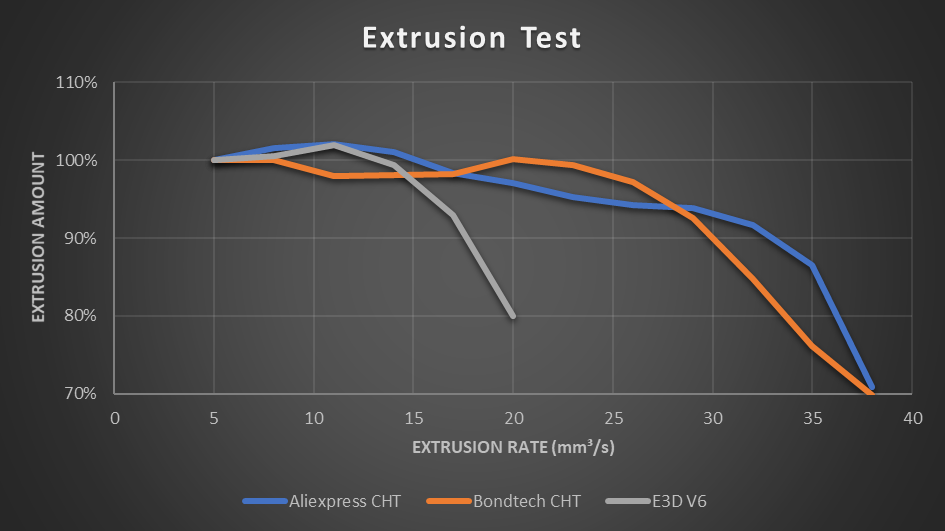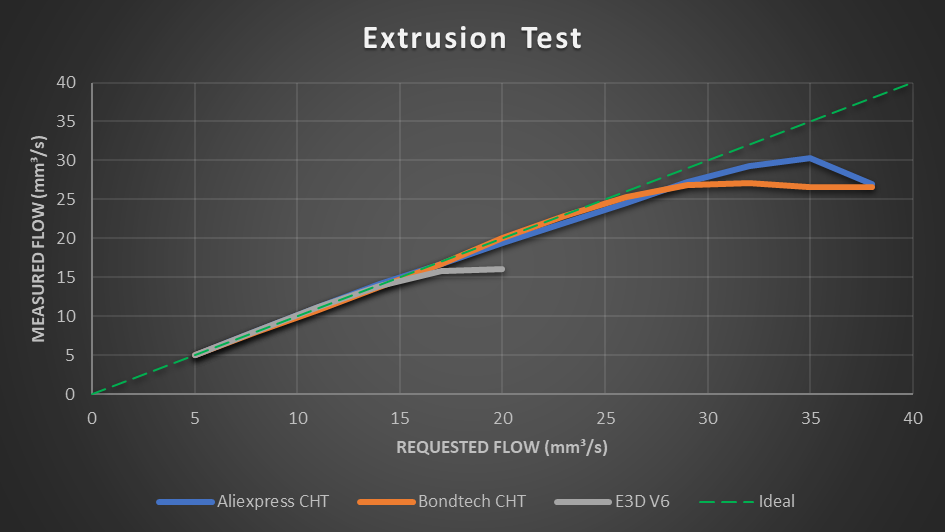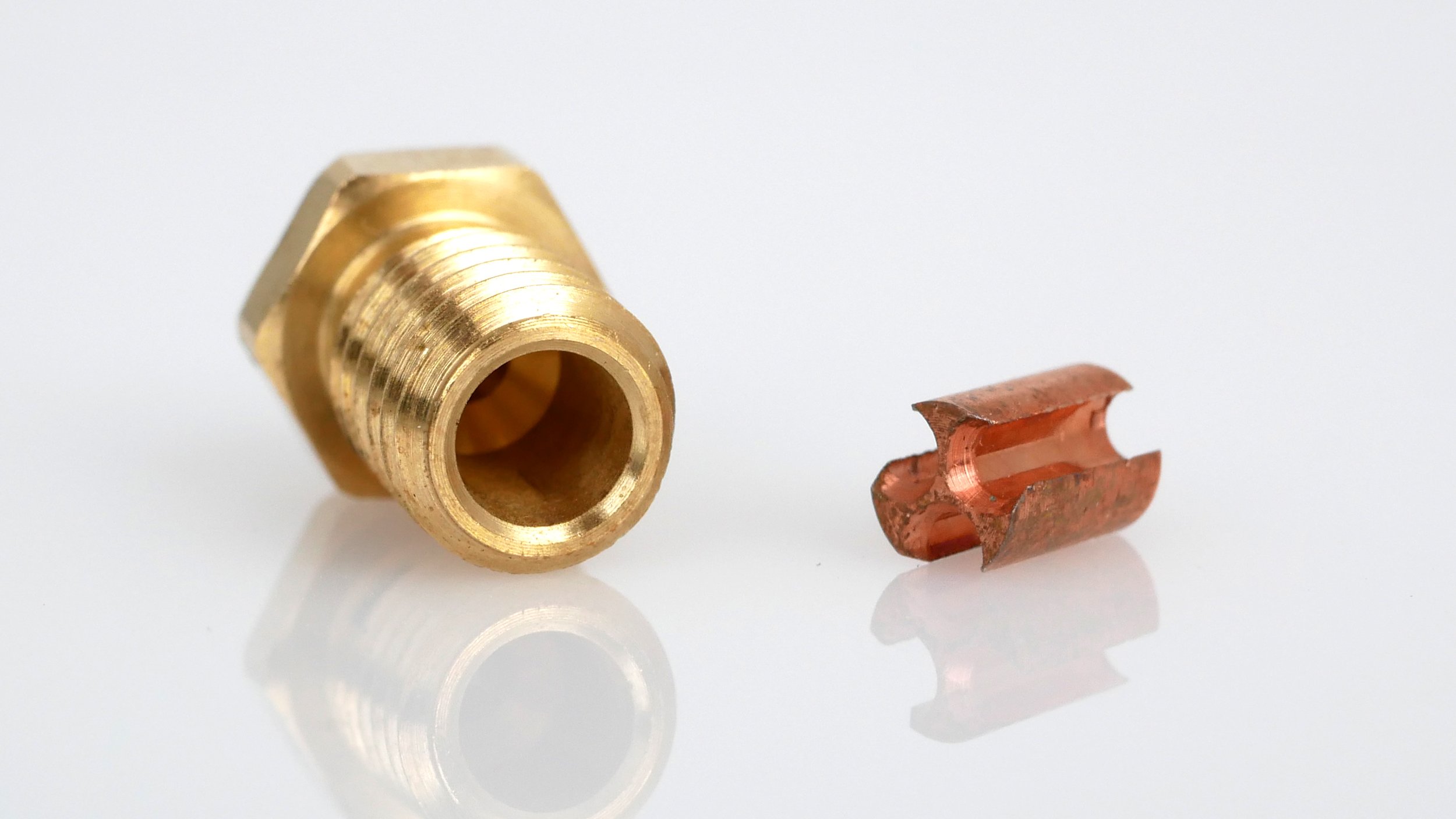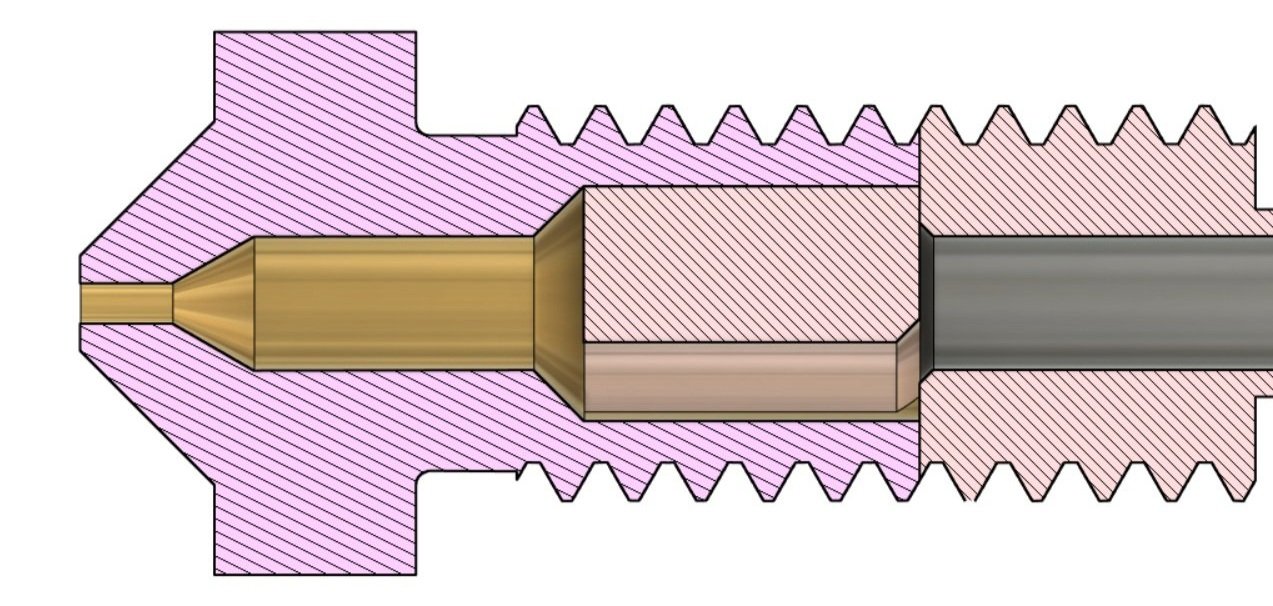Testing a $2 High-Flow nozzle from Aliexpress
3D printers have been becoming really fast recently, yet there is still one big physical challenge that holds them back and this is how fast you can get the material in the nozzle to melt. The thermal conductivity of plastics is almost by two orders of magnitude lower than the one in brass for example. This means that even though the 3D printer nozzle can be super hot, it takes a bit of time until the heat traveled into the filament to melt it. This means that at high speeds, when the filament is quickly pushed through the hotend, the core can still be solid, while the outside is already molten. Core Heating Technology tackled that by splitting up the filament into three individual strands that are then thinner and therefore melt faster, making it possible to basically double the maximum extrusion rate. Even though this technology is patented by 3DSolex where Carl uses it for awesome Ultimaker high-flow printcores, it, of course, didn’t take long until we saw knockoffs on the market, and even some printer manufacturers snuck special nozzles for higher flow capability into their machines. I would have even expected to see something like this on Bambulabs machines, but my cold pulls looked very clean and I think they were very cautious not to run into legal problems right at their launch. Talking about the patent, I think that 3DSolex and Bondtech deserve a ton of credit for their work but there are currently some interesting things happening around the patent, which I’ll discuss later.
Bondtech CHT
Anyways, a viewer send me one of them that he purchased from Aliexpress where they are selling for only 2 to $5 instead of the still reasonably priced $20 CHT from Bondtech. I deliberately didn’t put any links to the knockoffs in the description because they might infringe on the patent, and I want to stay out of legal trouble. I rather want to fund this objective investigation with your views, so consider feeding the YouTube algorithm by leaving a like, sharing it and leaving a comment below!
Aliexpress CHT
So let’s take the Aliexpress CHT and put it through its paces! Let’s first do an extrusion test, or as some like to call it, a poop test. Here I extrude beans of filament at increasing speeds and by measuring their weight, I can easily tell if we are under-extruding or not and compare the results of the Aliexpress nozzle, to a genuine Bondtech CHT and an E3D V6. All nozzles have the same 0.4 mm orifice size and I used the same hotend and extruder and an extrusion temperature of 215 °C with some very standard PLA.
Because I was curious, I started with the Aliexpress CHT and oh boy, was I impressed by the results. I started at 5 mm³/s and went all the way to 38 mm³/s. Usually, the last blobs are way smaller than in the beginning, because, at these high speeds the extruder is not able anymore to push hard enough and starts stripping and skipping. With the Aliexpress nozzle, even the last ones were hard to distinguish by size. I weighed them one after another and put the values into a chart, which shows that the extrusion amount slowly starts dropping until it completely drops down at around 30 mm³/s.
Extrusion Tests
I repeated the same procedure for a regular E3D V6 nozzle and Bondtechs CHT. A regular nozzle was way behind, topping off at only 16 mm³/s. Don’t get me wrong, for most printing on standard machines, this is totally sufficient and regular slicing profiles usually top out at 10 mm³/s or even less, yet if you want to print fast or use bigger layers a regular nozzle can be the limiting part. This is where the CHT comes in, where we have seen a doubling in performance in the past by only changing the nozzle itself. The flow test with the official genuine CHT was very similar to the one from Aliexpress. It actually even dropped off a little earlier and was only able to melt 27 mm³/s.


Before we investigate, if this also translates into real printing performance, let’s take a closer look at the Aliexpress CHT and how its design differs from Bondtechs high flow nozzle. From my previous investigation, I know that the Bondtech design is made from one piece of metal into which they drill at an angle to form the three channels and create the sharp blade that slices through the filament. The nozzle from Aliexpress uses a way simpler approach because they use a regular nozzle with an increased internal diameter and simply add a small piece of copper that has three off-center bores which are chamfered on one side. If my Aliexpress CHT wasn’t assembled in my bag to circumvent the patent or simply because it fell apart during shipping is something I don’t know, but what we have clearly seen from the test is that this loose fit works, even though there is no tight connection between the brass nozzle and the copper insert. When we take a closer look at the two designs we can also see that the Aliexpress CHT has way more material to transfer heat into the inside of the filament, compared to Bondtechs CHT, which might be the reason it works so well.
Aliexpress CHT
Interestingly enough, Bondtech uses a very similar insert approach for their new Volcano high flow nozzle and the abrasion-resistant CHT that will be available in January. If you, by the way, don’t want to miss the review of them, make sure to be subscribed! I suspect Bondtechs reason for using an insert is not to increase the size of the inner part but, in the case of the Volcano CHT, it’s a way to even manufacture it in the first place and on the abrasion-resistant CHT, they do this to have a hardened steel core and a very heat conductive sleeve for maximum performance!
Bondtechs upcomming abrasion-resistant CHT
Before we talk about the downsides of this insert design, let’s see how the extrusion performance translates to real printing, where internal stresses in the molten material will be more important, and also the cooling fan will be turned on. I did three different tests. First, a simple meandering part that I print in vase mode and increase the print speed every two mm. If you, by the way, want to try this yourself, I uploaded it together with a small manual on printables. In my tests, I started at 6 mm³/s and increased the extrusion speed every step by 2 mm³/s. The part printed with the standard V6 nozzle failed quite early due to skipping of the filament and didn’t get over 14 mm³/s. The Bondtech CHT print was significantly better and finished the whole part up to 30 mm³/s, yet I was able to spot very strange blob artifacts starting at 22 mm³/s. The print with the Aliexpress nozzle was quite similar and showed some minor layer inconsistencies from 24 mm³/s upwards. The interesting test, though, will be the print of a regular part with a ton of retracts where I wasn’t sure how the very uneven internal shape of the Aliexpress nozzle would perform.
Extrusion Test Meander (left: Bondtech CHT - right: Aliexpress CHT)
I first started with retraction towers. I had basically no more stringing at all after only setting the retraction to 0.4 mm. The Aliexpress high-flow nozzle behaved differently from everything else I’ve seen in the past. It also didn’t show any stringing at 0.4 mm but when the value increased, the hairs came back again. This also was very clearly visible in my first test print, where I had a ton of stringing at 1 mm retraction but only very little when I decreased it to 0.4 mm. In terms of printing quality, I could hardly see a difference between the contestants, and all were able to produce nice surfaces and overhangs.
Retraction test results (0 - 1 mm)
I had similar results on the 3D Benchies, which looked very nice if we disregard the ringing from the printer itself. The first set was printed at medium speeds with a maximum flow rate close to 10 mm³/s, whereas on the second batch, I increased the speed to 200%. Both of the Benchys printed with the high-flow nozzle looked fine, yet the one printed with the Bondtech CHT had a significantly more matte surface compared to the Aliexpress CHT, which is also a sign the knockoff melts the material more efficiently.
3D Benchy (left: Bondtech CHT - right: Aliexpress CHT)
So, all in all, I’m honestly very positively surprised about the cheap knockoff CHT. At least on my unit, the performance was on par with Bondtechs nozzle, maybe even a little better, and even regular prints didn’t look worse. The copper insert seems to do quite a good job splitting up the filament and heating and melting it efficiently. Yet it also comes with some downsides. At least mine wasn’t super nicely machined and I’m not sure if this small leftover chip would have blocked the orifice if it at some point broke off. I am a huge fan of cold-pulling my nozzles to remove residues, and with standard nozzles and even the CHT, this isn’t a problem, but the big slug and the step on the knockoff make this basically impossible.
Section Cut of an Aliexpress CHT
I had to assemble mine myself and if you don’t have good eyes there is a 50% chance that the copper insert is installed the wrong way with the chamfers pointing to the wrong side, which then blocks more of the filament path than it helps. And this is something I also heard from other sides during my research. For some, the nozzle seems to work well, others had big problems using it and this might just be due to inconsistent machining quality, which isn’t something I can say of the original Bondtech nozzle.
Aliexpress CHT with slug half inserted
And then there is also the problem with the patent. I’m not a lawyer and I don’t even want to get involved in these discussions but there is a significant chance that the Aliexpress CHT infringes the 3DSolex patent. The main patent claim is that a heat-conductive material, here our copper insert, is attached to the inside of the nozzle. Is a loosely inserted copper slug really attached to the wall only because there is heat transfer? Would that also mean that my butt is attached to my radiator, simply because I sit on it, and it warms me? I think you understand what I mean - patent language is hard and how you interpret these claims is something that layers need to do, but there are currently a lot of things happening because E3D opposes the patent in the EU and the US patent office rejected the patent in its current form. This doesn’t mean that 3DSolex won’t get the patent in the US, but they have to pour more money into it. We’ll see what the future holds. 3DSolex definitely deserves a ton of credit for coming up with the core heating technology for 3D printers and Bondtech deserves credit for its genius implementation and making it mainstream, yet we can also see, that patents inspire others and motivate them to design around these innovations, potentially coming up with even better solutions where we can all benefit from. If the Aliexpress CHT looks as it does because it’s easier to manufacture or because they wanted to avoid patent infringement is something I don’t know but the solution seems to work better than I expected, and just looking at the current design, there is still a ton of potential to improve it even more. And maybe in the end, calling it a knockoff wasn’t the right word, because this design even improves on some things! But what are your thoughts on these cheap Aliexpress CHT nozzles? Are they any good, or would you rather stick to the Bondtech CHT, because it works and it supports their innovation?
📚 Further information
CHT Patent: https://worldwide.espacenet.com/patent/search/family/058772617/publication/EP3445568A1?q=pn%3DEP3445568A1%3F
Patent Opposition by E3D: https://register.epo.org/application?documentId=L7J7SJWX17EOPSM&number=EP17725789&lng=en&npl=false
US Patent Office Rejection: https://register.epo.org/documentView?number=US.201716094482.A&documentId=1-15-US++160944821NP1+










